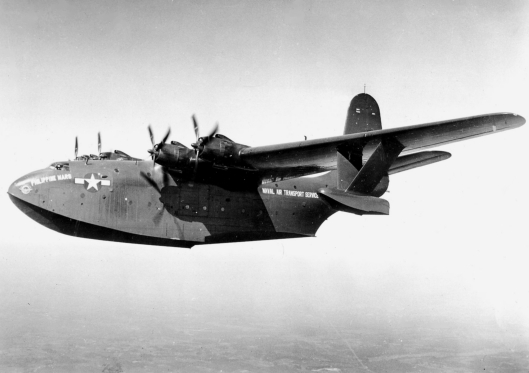
The Martin JRM-3 Philippine Mars (BuNo. 76820) of transport squadron VR-2 taking off from San Francisco Bay at NAS Alameda, California (USA) to Honululu, Hawaii, in 1946. A “long hull” Essex-class aircraft carrier painted in the wartime measure 21 is visible in the background. By 1956, the Mars had outlived its usefulness for the Navy and had been condemned to the scrap yard. However, after a series of disastrous fire seasons in British Columbia (Canada), a group of logging companies heard about the availability of the Mars. The Mars was ideally suited to British Columbia’s abundance of waterways and shortage of strategically placed airfields. Mr. MacMillan Bloedel took the initiative and formed Forest Industry Flying Tankers Limited (FIFT), in partnership with Pacific Forest Products Limited and TimberWest Forest Limited. The new company purchased the last four remaining Martin Mars from the US Navy in 1959. After installation of a 27276 l (7206 US gal) plywood holding tank and retractable filling probes. As of 2008 Philippine Mars is still in use by “Coulson Flying Tankers” with the Canadian registration C-FLYK.
The Mars was the largest military flying boat operated by the U.S. Navy. It served with distinction for 13 years, setting many range and payload records.
Martin developed its giant Model 170 to meet a 1938 Navy specification for a long-range patrol-bomber. The prototype, designated XPB2M, boasted a 200foot wingspan, 2 miles of internal piping, and 7.5 miles of wiring. It was unveiled as the world’s largest flying boat and first flew in July 1943. On its first actual trial flight in December 1943, the “Old Lady” carried 13,000 pounds of cargo from Patuxent River Naval Air Station, Maryland, to Natal, Brazil—a distance of 4,375 miles. Early the following year, it carried a 20,500pound load 4,700 miles from California to Hawaii. By the time the “Old Lady” was retired in March 1945, it had transported 3 million pounds of cargo throughout the Pacific without mishap. The Navy was sufficiently impressed to order 20 additional machines, but by that time the aircraft’s mission had been changed from patrol-bomber to transport.
By war’s end only five JRM1 and one JRM2 Mars flying boats had been completed, and the remainder was canceled. These planes differed from the prototype in sporting a single tailfin, for greater stability, and more powerful engines. One craft, the Caroline Mars, crashed only two weeks after being delivered, but the remaining five plied the important cargo routes of the Pacific with Navy Transport Squadron VR2. A second JRM, the Marshall Mars, was lost to fire in April 1950, but the four surviving machines rendered distinguished service until retirement in 1956. It is estimated that the Mars transported some 200,000 passengers more than 12 million miles. In July 1959 they were sold to Canada as firefighting aircraft and were outfitted with tanks that could hold 7,000 gallons of water. Two of these craft are still in service.
Type: Transport
Dimensions: wingspan, 200 feet; length, 117 feet, 3 inches; height, 38 feet, 5 inches
Weights: empty, 75,373 pounds; gross; 165,000 pounds
Power plant: 4 × 2,200–horsepower Wright Duplex Cyclone R3350 radial engines
Performance: maximum speed, 221 miles per hour; ceiling, 14,600 feet; maximum range, 4,945 miles
Armament: none
Service dates: 1943–1956